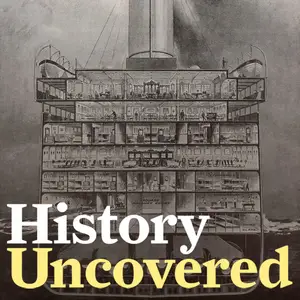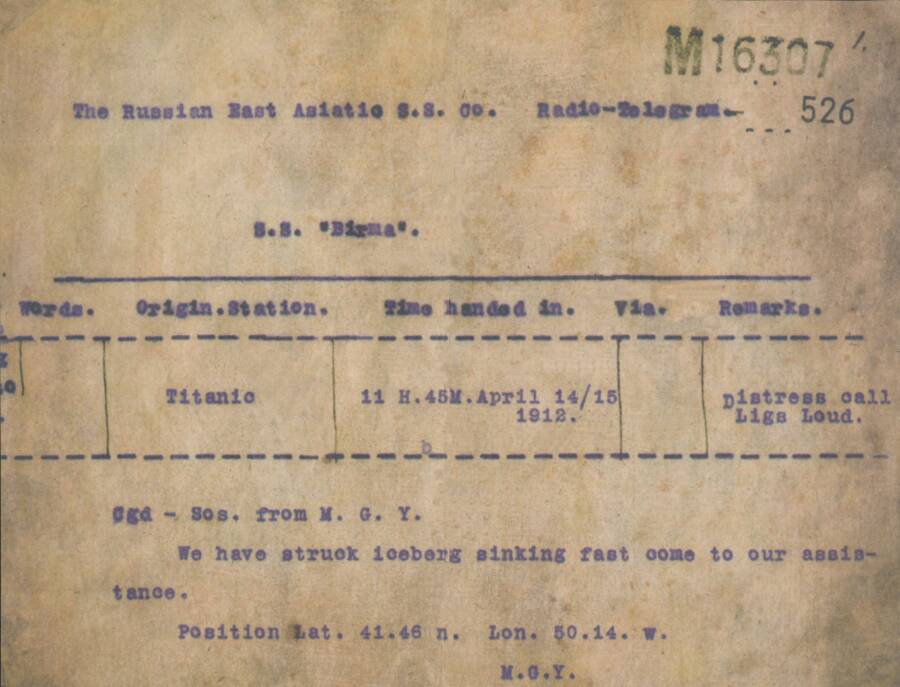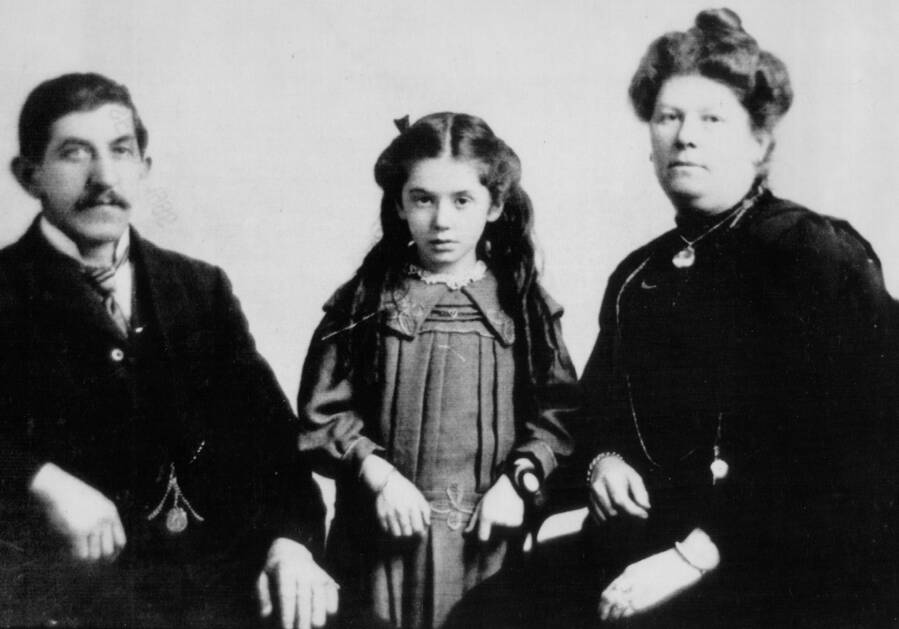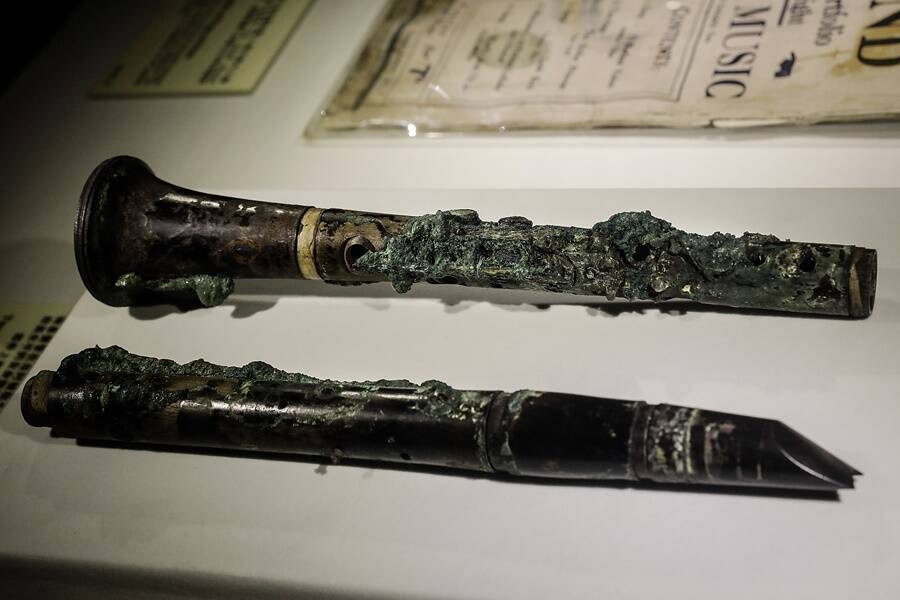On April 15, 1912, the RMS Titanic sank into the North Atlantic after striking an iceberg. These facts capture the magnitude of history's most infamous maritime disaster.
As the RMS Titanic sank into the icy black waters of the North Atlantic Ocean on April 15, 1912, it took more than two thirds of its 2,200 passengers and crew along with it. When the shocking story made its way back to land, the world struggled to fathom all of the facts about the Titanic and its demise.
Since then, the sinking of this “unsinkable” ship has fascinated people all over the world. What exactly happened on that fateful night? Why did the Titanic sink? How many people died in the water — and who survived?

Wikimedia CommonsThe tragic facts about the Titanic and its sinking present a tale of both great heartbreak and astonishing heroism amid disaster.
These interesting facts about the Titanic reveal everything you need to know about one of the most tragic disasters in human history.

The “Unsinkable” Titanic Was Celebrated As The Largest Ship Of Its Age
Today, the Titanic is synonymous with tragedy. But before April 15, 1912, it represented the marvels of modern technology.
As pictures of the Titanic show, it was the largest — and certainly most opulent — man-made moving object on Earth at the time, measuring 882-feet in length.
Indeed, it was not only the largest passenger ship in the world — it was also the largest ship ever built at 92 feet wide and weighing in at about 46,000 tons.
The Titanic Was Built In Belfast During A ‘Golden Age’ Of Shipbuilding
The Titanic was built at Harland and Wolff shipyard in Belfast, Ireland, and it took 15,000 men and 26 months to build it.
The White Star Line had commissioned the construction of three sister ships — the Titanic, the Olympic, and the Britannic.
Eerily, the Britannic also sank after hitting a mine in World War I. The Olympic, however, survived its career despite once colliding with another ship.
The Ship Was Considered The Epitome Of Luxury

Wikimedia CommonsThe grand staircase of the Titanic‘s sister ship, the Olympic, which is thought to be the tragic ship’s identical twin.
As anyone who has seen the movie Titanic knows, the ship was not only big — it was beautiful and luxurious. First-class passengers could enjoy the grand Titanic staircase, Turkish baths, and fine dining. The first-class menu included oysters, filet mignon, and eclairs.
Such an experience didn’t come cheap, however. First-class suites cost between about $1,700 and $50,000.
Although first-class passengers had a higher survival rate, their expensive cabins didn’t guarantee anything on the night the Titanic sank.
The Doomed Ship Sank On Its Maiden Voyage
The Titanic set off from Southampton, England on April 10, 1912, for its first-ever journey. The ship made stops in Cherbourg, France, and Queenstown, Ireland, which today is called Cobh. Then, the Titanic set sail for New York City.
But disaster struck only a few days into the trip. The ship wasn’t on sea for more than four days before its fateful sinking occurred.
The Titanic Was Doomed After Sideswiping An Iceberg

Wikimedia CommonsThe iceberg believed to have been struck by the Titanic (note the dark smear, said to be red paint from the collision).
Around 11:40 p.m. on April 14, 1912, the Titanic struck an iceberg. While trying to steer away from the iceberg at full speed, the ship was scraped on its starboard side, beneath the waterline.
The collision cut a hole in the ship’s hull. Before long, the Titanic began to fill with water.
The Titanic Sank On April 15, 1912 In The North Atlantic Ocean
The RMS Titanic was about 400 miles from Newfoundland when it sank into the frigid waters around 2:20 a.m. on April 15, 1912.
Although its crew sent desperate distress calls, no one came to help. The RMS Titanic slipped beneath the ocean waves.
The Titanic Took More Than Two Hours To Sink — All The While Its Band Played On
After striking the iceberg, the Titanic took two hours and 40 minutes to sink. But as the disaster unfolded, the ship’s band actually did resolve to keep playing, just as the popular lore describes.
Hoping to calm the passengers as they evacuated, the Titanic band played for two hours and five minutes.
The bandleader, Wallace Hartley, believed fiercely in the power of music. As his friend later remarked, “I know he often said that music was a bigger weapon for stopping disorder than anything on earth. He knew the value of the weapon he had, and I think he proved his point.”
Radio Operators Were Warned Multiple Times About Icebergs
Before striking an iceberg and sinking into the ocean, the crew of the Titanic had been warned six times about exactly that very danger. But the messages fell on deaf ears.
The radio operators were overwhelmed with the new radio technology, which resulted in an overwhelming number of messages flying back and forth.
At one point, the SS Californian sent a warning that it was already surrounded by ice. The Titanic’s chief telegraphist Jack Phillips snapped: “Shut up! I am busy.”

Print Collector/Getty ImagesOne of the Titanic‘s final telegrams reads: “We have struck iceberg sinking fast come to our assistance.”
Consequently, the telegraphist on the Californian went to bed and didn’t hear the Titanic‘s distress call a few hours later.
Phillips — who bravely sent distress calls until the Titanic sank — went down with the ship.
Titanic Facts: Binoculars May Have Saved The Ship
The Titanic sank because it hit an iceberg. But disaster could likely have been avoided if crew members had access to binoculars — which they couldn’t get to because they didn’t have a key.
The crew member with the key to the binoculars’ case had not boarded the Titanic. And one lookout — Frederick Fleet, who survived — later said that the binoculars could have helped them react fast “enough to get out of the way” of the iceberg.
Instead, the ship went full speed ahead — toward its doom.
Every Single One Of The Ship’s Engineers Died
The ship’s band weren’t the only people who died trying to save others. All 35 of the Titanic’s engineers also went down with the ship.
From below deck, they battled furiously to keep the ship’s lights, pumps, and radio going. Their sacrifice helped hundreds of people escape, as the lights didn’t go off until the ship plunged beneath the waves.
But they couldn’t save everyone.
About 1,500 People Died On The Titanic
Approximately 1,500 people — or two-thirds of the people on board — died when the Titanic sank. Among them were 832 passengers and 685 crew members.
Those who died included famous millionaires like, John Jacob Astor, as well as the designer of the Titanic, Thomas Andrews.
In all, first-class passengers had a higher rate of survival at 62 percent than second-class passengers, at 43 percent, or steerage passengers, at 25 percent.
Facts About The Titanic: Only 360 Bodies Were Ever Recovered From The Ocean
Although about 1,500 people died on the Titanic — and many froze in the water wearing life vests — only about 340 bodies were recovered.
After learning of the disaster, numerous vessels set out to help recover bodies. One was a cable ship called Mackay-Bennett, which took off from nearby Halifax.
That crew picked up 306 bodies, including a 19-month-old boy wearing four layers of clothing in a futile attempt to protect him from the cold water. But the ship left 100 bodies behind because they’d run out of embalming fluid.
The Dead Included Titanic Captain Edward Smith
The Titanic captain, Edward Smith, also went down with the ship. However, while some claim that he hid in his cabin, others describe him as helping children into lifeboats.
Smith is criticized for failing to heed ice warnings and for neglecting to properly oversee the filling of the lifeboats. But he’s also lauded for his “stiff upper lip” in the face of disaster.
“Well boys, you’ve done your duty and done it well. I ask no more of you,” he allegedly told his crew. “I release you. You know the rule of the sea. It’s every man for himself now, and God bless you.”
Titanic Facts: About 700 Survivors Managed To Escape The Ship
As the world awoke to a tragedy at sea, many newspapers swiftly reported that everyone had survived the Titanic sinking. In fact, only 706 survived — out of the total 2,240 passengers and crew.
The Titanic survivors were old and young, rich and poor, men and women. In stories the survivors told later, they described utter devastation.
“The sounds of people drowning are something that I can not describe to you, and neither can anyone else. It’s the most dreadful sound and there is a terrible silence that follows it,” remembered Titanic survivor Eva Hart.

Wikimedia CommonsEva Hart, center, survived alongside her mother Esther, right. But her father Benjamin, left, died in the sinking.
The last Titanic survivor to pass away, Millvina Dean, died in 2009. At the time of the sinking, she was just two months old — making her the youngest Titanic survivor as well as the last to remain.
Women Were Much More Likely To Survive Than Men, Regardless Of Class
“Women and children first” definitely applied on the Titanic. Only about 20 percent of the Titanic‘s male passengers survived. The number was higher for women at 74 percent and children at 52 percent.
Out of everyone on the doomed ship, first-class women had the best chance of survival. Approximately 97 percent of them survived the sinking.
Six Chinese Survivors Of The Titanic Were Written Out Of History
Although Titanic survivor stories generally focus on the British and Americans who survived, at least six Chinese men also survived the Titanic.
One survivor recounted that one of the Chinese men “worked like a hero” to row his lifeboat and help others. Nevertheless, they faced harsh discrimination once they arrived in the United States. Despite surviving the Titanic sinking, they were later deported.
The Small Number Of Lifeboats On The Titanic Contributed To The Death Toll
Although the Titanic‘s lifeboats saved hundreds of lives, they could have saved plenty more. The ship had only 20 lifeboats for 2,200 people — far fewer than the ship could have carried.
In fact, the Titanic could have carried as many as 64 lifeboats. Although the ship’s designer originally included 48, the “extra” 28 were scrapped to make the decks less cluttered.
Plus, the Titanic’s lifeboats often departed below capacity. Two collapsible lifeboats floated away with no passengers and 472 spaces went unused.
The Freezing Cold Water Around The Ship Rendered Life Jackets Useless
What the Titanic lacked in lifeboats it made up for in life jackets. The ship had about 3,500 cork-filled life jackets on board.
However, that did little good in the icy water. When the Titanic sank, the water temperature was a frigid 28 degrees Fahrenheit. Because the water was below freezing, it took only five minutes for people to freeze to death — whether or not they had a life jacket.

Wikimedia CommonsThe true facts about the Titanic‘s lifeboats only make the story of its sinking more tragic, as hundreds of seats aboard these rescue vessels went unused.
Either A Fire Or The Northern Lights Might Have Also Contributed To The Disaster
It’s well established that the Titanic struck an iceberg. But why did the Titanic sink? And how? There may have been multiple factors at play.
An Irish journalist named Senan Molony claimed that a black streak seen in photos of the Titanic as it left port is evidence of a fire in the coal bunker. He believes this fire may have weakened the ship and contributed to its sinking.
Another possibility is that the charged particles from the Northern Lights could have confused the Titanic‘s navigation systems and hindered its calls for help.
There Is A Titanic Conspiracy Theory That The Disaster Was All Planned
Some dismiss the iceberg outright and instead posit that the Titanic was sunk on purpose.
This theory claims that American financier J.P. Morgan orchestrated the sinking to eliminate rivals like John Jacob Astor. Reportedly, Morgan had originally planned to be on the Titanic himself, but at the last minute extended his stay in Europe.
Of course, there’s absolutely no proof for this larger theory. Other Titanic conspiracy theories insist that the ship never sank at all, a claim that withered after the wreck was found.
The Wreck Of The Titanic Was Only Discovered Recently — And It’s Disappearing Fast
For decades, the Titanic was literally lost at sea. But a joint French-American expedition found the Titanic wreck on Sept. 1, 1985 — 73 years after it sank.
They discovered the Titanic 400 miles east of Newfoundland in the North Atlantic Ocean, at about 13,000 feet beneath the surface.
The “man who found the Titanic,” Robert Ballard, discovered the wreck while executing a secret mission for the U.S. military. After finding the remains of two nuclear subs as he was instructed, he was then free to pursue his passion project of finding the Titanic.
However, the Titanic wreck is steadily disappearing due to metal-eating bacteria.
Facts About The Titanic: Divers Have Recovered A Number Of Stunning Artifacts From The Wreck
Since Ballard’s 1985 discovery, a private American company called RMS Titanic, Inc. has salvaged more than 5,000 artifacts from the Titanic.

Wang He/Getty ImagesA clarinet recovered from the wreckage.
They include instruments from the ship’s band, the whistle of an officer who saved lives during the sinking, the ship’s telegraph, old currency, clothing, jewelry, dishware, and even the ship’s luxurious chandelier.
After reading these 22 facts about the Titanic, check out these rare photos of the Titanic before and after its sinking. Then, see actual footage of the Titanic that captures the doomed ship just before it sank.





